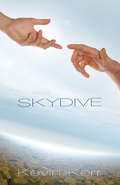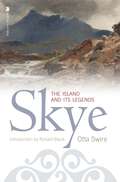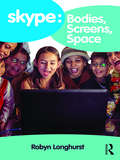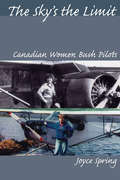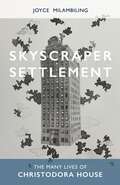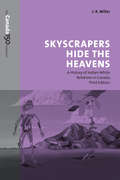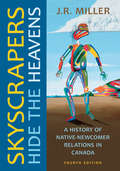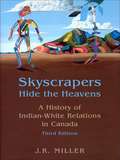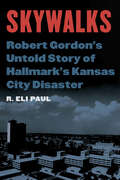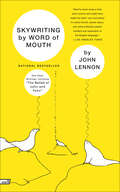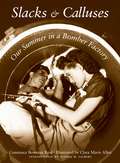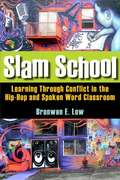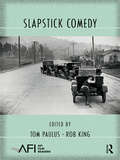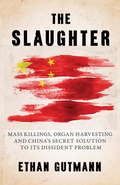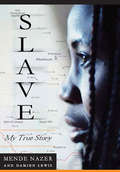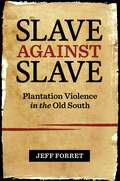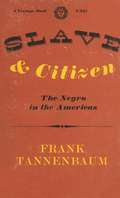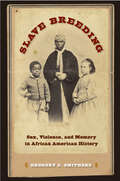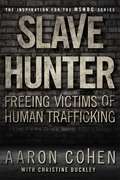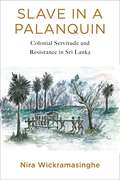- Table View
- List View
The Sky Watched: Poems of Ojibwe Lives
by Linda LeGarde GroverA collective memoir in poetry of an Ojibwe family and tribal community, from creation myth to this day, updated with new poems Reaching from the moment of creation to the cry of a newborn, The Sky Watched gives poetic voice to Ojibwe family life. In English and Ojibwe, those assembled here—voices of history, of memory and experience, of children and elders, Indian boarding school students, tribal storytellers, and the Manidoog, the unseen beings who surround our lives—come together to create a collective memoir in poetry as expansive and particular as the starry sky.This world unfolds in the manner of traditional Ojibwe storytelling, shaped by the seasons and the stages of life, marking the significance of the number four in the Ojibwe worldview. Summoning spiritual and natural lore, award-winning poet and scholar Linda LeGarde Grover follows the story of a family, a tribe, and a people through historical ruptures and through intimate troubles and joys—from the sundering of Ojibwe people from their land and culture to singular horrors like the massacre at Wounded Knee to personal trauma suffered at Indian boarding schools. Threaded throughout are the tribal traditions and knowledge that sustain a family and a people through hardship and turmoil, passed from generation to generation, coming together in the manifold power and beauty of the poet&’s voice.
Skydive
by Kevin KerrHaving grown apart after a traumatic and defining moment in their youth, two brothers reconnect to fulfill a life-long ambition to go skydiving. Skydive explores the world of dreams and imagination: the universal human desire to push beyond our physical limitations and to fly.
Skye: The Island and Its Legends (Landscapes In Stone Ser.)
by Otta SwireAn oral history by &“Scotland&’s forgotten folklorist&” whose tale inspired the Neil Gaiman novella The Truth Is a Cave in the Black Mountains (The Spooky Isles). This is a fabulous treasury of legend and wonder—tales of monsters who dwell in lakes; of small people who trap humans in earthen mounds where time stands still; of dark, shapeshifting spirits whose cloak of human form is betrayed by the sand and shells which fall from their hair. In the absence of a written tradition, for generations of skianachs, these tales, handed down orally, contained the very warp and weft of Hebridean history. They take us far beyond Christian times, to the edge of the Iron Age, and interweave with threads from the wider Atlantic tradition of Gaelic heroic myth and legend. Absolute Escapes—which lists Skye as one of the &“8 Books You Should Read Before Visiting Scotland&”—raves, &“This fascinating book written in the 1950s still has relevance today as it maps a route around the island, mixing mythology and local history to capture the spirit of the land and its legends. This is a great guide to the Isle of Skye, and a jolt to the imagination.&” &“Swire&’s prose makes for a very entertaining read . . . as a source of folklore, it&’s unbeatable.&” —The Spooky Isles
Skype: Bodies, Screens, Space,
by Robyn LonghurstDespite the popularity of Skype with video many of us are still figuring out how to ‘do’ it. Interviews reveal that we can now run the programme but we are less certain about how to ‘perform’ in front of the webcam. Seeing ourselves in the box on the side can feel strange. We are not quite sure which bits of our bodies to display on the screen, how much to move around the room, or move the device around the room. Is it acceptable to use Skype with video at a funeral, in crowded spaces or while in bed? This book addresses how people are emotionally and affectually connecting with others audio-synchronously on the screen in a variety of different spatial contexts. Topics include Skype with video being used by grandparents to connect with grandchildren, friends and family using it for special occasions, and partners using it for romance and sex. Theories addressing bodies, gender, queerness, phenomenology and orientation inform the research. It concludes that while Skype does not offer some kind of utopian future, it does open up possibilities for existing power relations to be filtered through new lines of sight/site which are shaping what bodies can do and where.
The Sky's the Limit: Canadian Women Bush Pilots
by Joyce SpringThe women pilots profiled in this book have flown from British Columbia to Newfoundland and in the Northwest Territories and Nunavut. Right from the beginning of her interviews and research, the author found herself constantly amazed by the achievements of the women involved. Within the book are the stories of early Canadian women bush pilots from the late 1940s onwards. Their stories are exciting, occasionally funny, and always absorbing. Ranging from aerial surveys, water bombing of fires, flying fish, canoes and northern dogs, to the operation of a float-plane flying school, these women have left little undone. One pilot, Judy Cameron, was the first Canadian woman to be hired by an airline. Flying north of Superior, Elizabeth Wieben recalls the time that she flew naked. In pilot Suzanne Pettigrew’s own words, "We sure have come a long way and the ride was an awful lot of fun."
Skyscraper Settlement: The Many Lives of Christodora House
by Joyce MilambilingThe roles that Christodora House has played from 19th-century settlement house to its newest formsSettlement house workers helped transform the lives of thousands of people despite lack of funding, the influenza epidemic of 1918, economic depressions, and two World Wars. Many of these houses still exist in the original neighborhoods where they confront the problems of today and advocate for their communities.Christodora House, founded in 1897 as “The Young Women’s Settlement,” played an important role in the life of immigrants and other residents on the Lower East Side of Manhattan. For over 50 years, residents and volunteers at Christodora House provided classes, clubs, recreational activities, and medical and dental clinics for thousands of New Yorkers, and then continued to operate programs out of public housing and other locations for more than two decades.The building at 143 Avenue B, now housing condominiums, has had a tumultuous history since 1948 but still stands, towering over its tenement neighborhood in the East Village. Christodora Inc. is now a nonprofit foundation with offices in Midtown Manhattan, whose staff works with underserved New Yorkers, including youth in the public school system, carrying on a long, distinguished history of service to the city and country.
Skyscrapers Hide the Heavens: A History of Indian-White Relations in Canada
by J. R. MillerHighly acclaimed when the first edition appeared in 1989, "Skyscrapers Hide the Heavens" is the first comprehensive account of Indian-white relations throughout Canada's history. J.R. Miller charts the deterioration of the relationship from the initial, mutually beneficial contact in the fur trade to the current impasse in which Indians are resisting displacement and marginalization.This new edition is the result of substantial revision to incorporate current scholarship and bring the text up to date. It includes new material on the North, and reflects changes brought about by the Oka crisis, the sovereignty issue, and the various court decisions of the 1990s. It also includes new material on residential schools, treaty making, and land claims.
Skyscrapers Hide the Heavens: A History of Native-Newcomer Relations in Canada, Fourth Edition
by J. R. MillerFirst published in 1989, Skyscrapers Hide the Heavens continues to earn wide acclaim for its comprehensive account of Native-newcomer relations throughout Canada’s history. Author J.R. Miller charts the deterioration of the relationship from the initial, mutually beneficial contact in the fur trade to the current displacement and marginalization of the Indigenous population. The fourth edition of Skyscrapers Hide the Heavens is the result of considerable revision and expansion to incorporate current scholarship and developments over the past twenty years in federal government policy and Aboriginal political organization. It includes new information regarding political organization, land claims in the courts, public debates, as well as the haunting legacy of residential schools in Canada. Critical to Canadian university-level classes in history, Indigenous studies, sociology, education, and law, the fourth edition of Skyscrapers will be also be useful to journalists and lawyers, as well as leaders of organizations dealing with Indigenous issues. Not solely a text for specialists in post-secondary institutions, Skyscrapers Hide the Heavens explores the consequence of altered Native-newcomer relations, from cooperation to coercion, and the lasting legacy of this impasse.
Skyscrapers Hide the Heavens
by J. R. MillerHighly acclaimed when the first edition appeared in 1989, "Skyscrapers Hide the Heavens" is the first comprehensive account of Indian-white relations throughout Canada's history. J.R. Miller charts the deterioration of the relationship from the initial, mutually beneficial contact in the fur trade to the current impasse in which Indians are resisting displacement and marginalization.This new edition is the result of substantial revision to incorporate current scholarship and bring the text up to date. It includes new material on the North, and reflects changes brought about by the Oka crisis, the sovereignty issue, and the various court decisions of the 1990s. It also includes new material on residential schools, treaty making, and land claims.
Skywalks: Robert Gordon's Untold Story of Hallmark's Kansas City Disaster
by R. Eli PaulIn 1981 the suspended walkways—or &“skywalks&”—in Kansas City&’s Hyatt Regency hotel fell and killed 114 people. It was the deadliest building collapse in the United States until the fall of New York&’s Twin Towers on 9/11. In Skywalks R. Eli Paul follows the actions of attorney Robert Gordon, an insider to the bitter litigation that followed. Representing the plaintiffs in a class action lawsuit against those who designed, built, inspected, owned, and managed the hotel, Gordon was tenacious in uncovering damaging facts. He wanted his findings presented before a jury, where his legal team would assign blame from underlings to corporate higher-ups, while securing a massive judgment in his clients&’ favor. But when the case was settled out from under Gordon, he turned to another medium to get the truth out: a quixotic book project that consumed the rest of his life. For a decade the irascible attorney-turned-writer churned through a succession of high-powered literary agents, talented ghost writers, and New York trade publishers. Gordon&’s resistance to collaboration and compromise resulted in a controversial but unpublishable manuscript, &“House of Cards,&” finished long after the public&’s interest had waned. His conclusions, still explosive but never receiving their proper attention, laid the blame for the disaster largely at the feet of the hotel&’s owner and Kansas City&’s most visible and powerful corporation, Hallmark Cards Inc. Gordon gave up his lucrative law practice and lived the rest of his life as a virtual recluse in his mansion in Mission Hills, Kansas. David had fought Goliath, and to his despair, Goliath had won. Gordon died in 2008 without ever seeing his book published or the full truth told. Skywalks is a long-overdue corrective, built on a foundation of untapped historical materials Gordon compiled, as well as his own unpublished writings.
Skywriting by Word of Mouth
by John LennonJohn Lennon wrote Skywriting by Word of Mouth, an impressive collection of writings and drawings, during Yoko Ono's pregnancy with Sean, and always planned to have it published. The book's publication was a wish that seemed to end with Lennon's assassination in 1980 and the theft of the manuscript from the Lennons' home in 1982. When it was recovered and first published in 1986, Skywriting received immediate critical and popular acclaim. Filled with Lennon's extraordinary creative powers and lavishly illustrated with his own drawings, the collection reveals his fertile creative spirit up close and in full force. Included in Skywriting are "Two Virgins," written when the public learned that John and Yoko were living together as husband and wife, and John's only autobiography, "The Ballad of John and Yoko." In addition there are notes on his falling in love with Yoko, the breakup of the Beatles, his persecution by U.S. authorities, and his withdrawal from public life. This is a book with John Lennon's spirit on every page—a spirit the world needs to remember.
Slacks and Calluses: Our Summer in a Bomber Factory
by Clara Marie Allen Constance BowmanIn 1943 two spirited young teachers decided to do their part for the war effort by spending their summer vacation working the swing shift on a B-24 production line at a San Diego bomber plant. Entering a male-dominated realm of welding torches and bomb bays, they learned to use tools that they had never seen before, live with aluminum shavings in their hair, and get along with supervisors and coworkers from all walks of life. They also learned that wearing their factory slacks on the street caused men to treat them in a way for which their "dignified schoolteacher-hood" hadn't prepared them. At times charming, hilarious, and incredibly perceptive, Slacks and Calluses brings into focus an overlooked part of the war effort, one that forever changed the way the women were viewed in America.From the Trade Paperback edition.
Slam School: Learning Through Conflict in the Hip-hop and Spoken Word Classroom
by Bronwen E. LowIn this study, Low (education, McGill U. , Canada) relates how a white teacher implemented the study of hip-hop and spoken word culture into urban high school language arts classes, which she co-taught and helped develop the curriculum for. She analyzes the dynamics of teaching and learning in these classes to argue that the reasons that teachers and administrators resist introducing hip-hop into curriculum--its complex issues of gender, violence, sexuality, materialism, race, and language--are what make it important pedagogically. She focuses on African American youth in interaction with white youth, teachers, and administrators, describing the student's exploration of poetry performance and writing and their experiences with the language of the hip-hop culture. Annotation ©2011 Book News, Inc. , Portland, OR (booknews. com)
Slanted and Enchanted: The Evolution of Indie Culture
by Kaya OakesA lively examination of the spirit and practices that have made the indie movement into a powerful cultural phenomenonYou know the look: skinny jeans, Chuck Taylors, perfectly mussed bed-head hair; You know the music: Modest Mouse, the Shins, Pavement. You know the ethos: DIY with a big helping of irony. But what does it really mean to be "indie"? As popular television shows adopt indie soundtracks and the signature style bleeds into mainstream fashion, the quirky individuality of the movement seems to be losing ground. In Slanted and Enchanted, Kaya Oakes demonstrates how this phase is part of the natural cycle of a culture that reinvents itself continuously to preserve its core ideals of experimentation, freedom, and collaboration. Through interviews and profiles of the artists who have spearheaded the cause over the years—including Mike Watt, David Berman, Kathleen Hanna, and Dan Clowes—Oakes examines the collective creativity and cross-genre experimentation that are the hallmarks of this popular lifestyle trend. Her visits to music festivals, craft fairs, and smaller collectives around the country round out the story, providing a compelling portayal of indie life on the ground. Culminating in the current indie milieu of music, crafting, style, art, comics, and zines, Oakes reveals from whence indie came and where it will go next.
Slaphappy: Pride, Prejudice, and Professional Wrestling
by Thomas HackettSlaphappy is reporter Thomas Hackett's penetrating look at the world of professional wrestling, for those who love the spectacle and for the sport's skeptics and the uninitiated. Through interviews with wrestlers, promoters, and fans, Hackett explores the full range of issues that swirl around wrestling culture -- fame, masculinity, violence, aggression, performance, and play. Among the lessons of professional wrestling is that deceit is a fundamental fact of American life. And yet, paradoxically, the one thing wrestling isn't is dishonest. Although wrestlers play pretend, wrestling itself doesn't pretend to be anything other than what it is -- fantastically absurd, a very American kind of madness. Celebrity-obsessed, pathologically narcissistic, murderously competitive, it both epitomizes and parodies the delusional egoism at the heart of the culture.More than that, wrestling provides its fans and performers a medium for thinking about "getting over" in America today. This spectacle of excess may be the apotheosis of American imbecility, but it is also defiant, hopeful, liberating, and unifying -- a throwback to the raucous pleasures of early theater. Fans aren't detached connoisseurs, looking satirically down on life, concealing their anxieties in the cold comforts of irony. They are total participants in a carnival of their own making, shouting epithets, throwing chairs, expatiating their worries in a crowd's triumphant foolishness.It is, Slaphappy concludes, all the stuff of human culture. Where does fantasy end and reality begin? Where does the performance stop and life take over? Writing with affection and discernment, Hackett gets deep into the culture, discovering that the make-believe competition of wrestling is indeed "real" for millions of young men -- real in the sense that something real and important is at stake: their worth as men.
Slapstick Comedy (AFI Film Readers)
by Tom PaulusFrom Chaplin’s tramp to the Bathing Beauties, from madcap chases to skyscraper perils, slapstick comedy supplied many of the most enduring icons of American cinema in the silent era. This collection of fourteen essays by prominent film scholars challenges longstanding critical dogma and offers new conceptual frameworks for thinking about silent comedy’s place in film history and American culture. The contributors discuss a broad range of topics including the contested theatrical or cinematic origins of slapstick; the comic spectacle of crazy technology and trick stunts; the filmmakers who shaped the style of early slapstick; and comedy’s implications for theories of film form and spectatorship. This volume is essential reading for anyone seeking to understand the origins and continued importance of a film genre at the heart of American cinema from its earliest days to today.
The Slaughter
by Ethan GutmannThe inside story of China's organ transplant business and its macabre connection with internment camps and killing fields for arrested dissidents, especially the adherents of Falun Gong.Mass murder is alive and well. That is the stark conclusion of this comprehensive investigation into the Chinese state's secret program to get rid of political dissidents while profiting from the sale of their organs--in many cases to Western recipients. Based on interviews with top-ranking police officials and Chinese doctors who have killed prisoners on the operating table, veteran China analyst Ethan Gutmann has produced a riveting insider's account--culminating in a death toll that will shock the world. Why would the Chinese leadership encourage such a dangerous perversion of their medical system? To solve the puzzle, Gutmann journeyed deep into the dissident archipelago of Falun Gong, Tibetans, Uighurs and House Christians, uncovering an ageless drama of resistance, eliciting confessions of deep betrayal and moments of ecstatic redemption. In an age of compassion fatigue, Gutmann relies on one simple truth: those who have made it back from the gates of hell have stories to tell. And no matter what baggage the reader may bring along, their preconceptions of China will not survive the trip.From the Hardcover edition.
Slave: My True Story
by Damien Lewis Mende NazerMende Nazer lost her childhood at age twelve, when she was sold into slavery. It all began one horrific night in 1993, when Arab raiders swept through her Nuba village, murdering the adults and rounding up thirty-one children, including Mende. Mende was sold to a wealthy Arab family who lived in Sudan's capital city, Khartoum. So began her dark years of enslavement. Her Arab owners called her "Yebit," or "black slave." She called them "master." She was subjected to appalling physical, sexual, and mental abuse. She slept in a shed and ate the family leftovers like a dog. She had no rights, no freedom, and no life of her own. Normally, Mende's story never would have come to light. But seven years after she was seized and sold into slavery, she was sent to work for another master-a diplomat working in the United Kingdom. In London, she managed to make contact with other Sudanese, who took pity on her. In September 2000, she made a dramatic break for freedom. Slave is a story almost beyond belief. It depicts the strength and dignity of the Nuba tribe. It recounts the savage way in which the Nuba and their ancient culture are being destroyed by a secret modern-day trade in slaves. Most of all, it is a remarkable testimony to one young woman's unbreakable spirit and tremendous courage.
Slave Against Slave: Plantation Violence in the Old South
by Jeff ForretIn the first-ever comprehensive analysis of violence between slaves in the antebellum South, Jeff Forret challenges persistent notions of slave communities as sites of unwavering harmony and solidarity. Though existing scholarship shows that intraracial black violence did not reach high levels until after Reconstruction, contemporary records bear witness to its regular presence among enslaved populations. Slave against Slave explores the roots of and motivations for such violence and the ways in which slaves, masters, churches, and civil and criminal laws worked to hold it in check. Far from focusing on violence alone, Forret's work also adds depth to our understanding of morality among the enslaved, revealing how slaves sought to prevent violence and punish those who engaged in it. Forret mines a vast array of slave narratives, slaveholders' journals, travelers' accounts, and church and court records from across the South to approximate the prevalence of slave-against-slave violence prior to the Civil War. A diverse range of motives for these conflicts emerges, from tensions over status differences, to disagreements originating at work and in private, to discord relating to the slave economy and the web of debts that slaves owed one another, to courtship rivalries, marital disputes, and adulterous affairs. Forret also uncovers the role of explicitly gendered violence in bondpeople's constructions of masculinity and femininity, suggesting a system of honor among slaves that would have been familiar to southern white men and women, had they cared to acknowledge it. Though many generations of scholars have examined violence in the South as perpetrated by and against whites, the internal clashes within the slave quarters have remained largely unexplored. Forret's analysis of intraracial slave conflicts in the Old South examines narratives of violence in slave communities, opening a new line of inquiry into the study of American slavery.
Slave and Citizen
by Frank TannenbaumOriginally published in 1947, Slave and Citizen is a classic in the field of comparative slave history and race relations.
Slave Breeding: Sex, Violence, and Memory in African American History
by Gregory D. SmithersFor over two centuries, the topic of slave breeding has occupied a controversial place in the master narrative of American history. From nineteenth-century abolitionists to twentieth-century filmmakers and artists, Americans have debated whether slave owners deliberately and coercively manipulated the sexual practices and marital status of enslaved African Americans to reproduce new generations of slaves for profit.In this bold and provocative book, historian Gregory Smithers investigates how African Americans have narrated, remembered, and represented slave-breeding practices. He argues that while social and economic historians have downplayed the significance of slave breeding, African Americans have refused to forget the violence and sexual coercion associated with the plantation South. By placing African American histories and memories of slave breeding within the larger context of America’s history of racial and gender discrimination, Smithers sheds much-needed light on African American collective memory, racialized perceptions of fragile black families, and the long history of racially motivated violence against men, women, and children of color.
Slave Country: American Expansion and the Origins of the Deep South
by Adam RothmanSlave Country tells the tragic story of the expansion of slavery in the new United States. In the wake of the American Revolution, slavery gradually disappeared from the northern states and the importation of captive Africans was prohibited. Yet, at the same time, the country's slave population grew, new plantation crops appeared, and several new slave states joined the Union. Adam Rothman explores how slavery flourished in a new nation dedicated to the principle of equality among free men, and reveals the enormous consequences of U.S. expansion into the region that became the Deep South. Rothman maps the combination of transatlantic capitalism and American nationalism that provoked a massive forced migration of slaves into Louisiana, Alabama, and Mississippi. He tells the fascinating story of collaboration and conflict among the diverse European, African, and indigenous peoples who inhabited the Deep South during the Jeffersonian era, and who turned the region into the most dynamic slave system of the Atlantic world. Paying close attention to dramatic episodes of resistance, rebellion, and war, Rothman exposes the terrible violence that haunted the Jeffersonian vision of republican expansion across the American continent. Slave Country combines political, economic, military, and social history in an elegant narrative that illuminates the perilous relation between freedom and slavery in the early United States. This book is essential reading for anyone interested in an honest look at America's troubled past.
Slave Families and the Hato Economy in Puerto Rico
by David M. StarkScholarship on slavery in the Caribbean frequently emphasizes sugar and tobacco production, but this unique work illustrates the importance of the region’s hato economy—a combination of livestock ranching, foodstuff cultivation, and timber harvesting—on the living patterns among slave communities. David Stark makes use of extensive Catholic parish records to provide a comprehensive examination of slavery in Puerto Rico and across the Spanish Caribbean. He reconstructs slave families to examine incidences of marriage, as well as birth and death rates. The result are never-before-analyzed details on how many enslaved Africans came to Puerto Rico, where they came from, and how their populations grew through natural increase. Stark convincingly argues that when animal husbandry drove much of the island’s economy, slavery was less harsh than in better-known plantation regimes geared toward crop cultivation. Slaves in the hato economy experienced more favorable conditions for family formation, relatively relaxed work regimes, higher fertility rates, and lower mortality rates.
Slave Hunter: One Man's Global Quest to Free Victims of Human Trafficking
by Aaron Cohen Christine BuckleyFrom living the rock star life to wading through the world's war zones, refugee camps, and brothels, Aaron Cohen left behind his closest friends, his dying father, and his partnership with a legendary musician to take on treacherous rescue missions in search of modern-day slaves.
Slave in a Palanquin: Colonial Servitude and Resistance in Sri Lanka
by Nira WickramasingheFor hundreds of years, the island of Sri Lanka was a crucial stopover for people and goods in the Indian Ocean. For the Dutch East India Company, it was also a crossroads in the Indian Ocean slave trade. Slavery was present in multiple forms in Sri Lanka—then Ceylon—when the British conquered the island in the late eighteenth century and began to gradually abolish slavery. Yet the continued presence of enslaved people in Sri Lanka in the nineteenth century has practically vanished from collective memory in both the Sinhalese and Tamil communities.Nira Wickramasinghe uncovers the traces of slavery in the history and memory of the Indian Ocean world, exploring moments of revolt in the lives of enslaved people in the wake of abolition. She tells the stories of Wayreven, the slave who traveled in the palanquin of his master; Selestina, accused of killing her child; Rawothan, who sought permission for his son to be circumcised; and others, enslaved or emancipated, who challenged their status. Drawing on legal cases, petitions, and other colonial records to recover individual voices and quotidian moments, Wickramasinghe offers a meditation on the archive of slavery. She examines how color-based racial thinking gave way to more nuanced debates about identity, complicating conceptions of blackness and racialization. A deeply interdisciplinary book with a focus on recovering subaltern resistance, Slave in a Palanquin offers a vital new portrait of the local and transnational worlds of the colonial-era Asian slave trade in the Indian Ocean.

